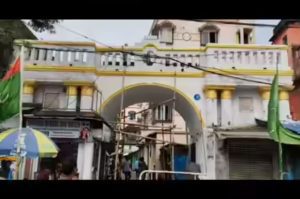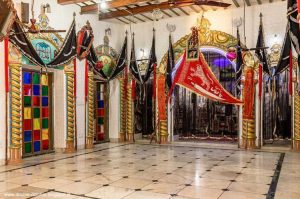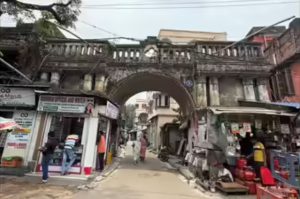Tollygunge Ghari Ghar Restored — A long-neglected piece of Kolkata’s cultural fabric has been brought back to life, thanks to the efforts of concerned citizens and conservationists. The iconic Ghari Ghar, a 19th-century heritage gateway located in Tollygunge near Deshapran Sashmal Road, has undergone significant restoration, marking a rare victory for community-led preservation efforts in the city.
This arched gateway, originally built around 1877 by Prince Sayyid Raheemuddin Shah, the great-grandson of Tipu Sultan, once served as the entrance to an Imambara, a sacred Shia congregation hall. The structure stands adjacent to the Tipu Sultan Mosque in South Kolkata and had gradually fallen into a state of disrepair—until now.

Historical Significance
The Ghari Ghar (clock tower), once a symbol of regal architecture and religious heritage, bore inscriptions in Urdu and Bengali, and featured classic Tuscan columns — a unique fusion of Indo-Islamic and colonial influences. It was originally built as a memorial, carrying an engraved date of construction and the name of its builder in the Nastaliq script.
Despite its historical and architectural merit, the structure had remained in obscurity. Over time, pollution, weathering, and lack of maintenance had left it cracked, stained, and nearly forgotten—its significance nearly lost in the bustle of modern Tollygunge.


Restoration Led by Citizens
The movement to restore the Ghari Ghar began with Kolkata Restorers, a civic group known for rejuvenating neglected heritage sites. The project was executed with the support of the Wakf Board, under the guidance of Humayun Mirza, a descendant of both Tipu Sultan and Nawab Wajid Ali Shah.
Architect Anjan Mitra, a veteran in heritage conservation, led the restoration process, which included:
-
Crack repair and structural stabilization
-
Lime-wash painting to maintain architectural authenticity
-
Gentle surface cleaning to preserve original masonry
-
Façade illumination to restore nighttime visibility
The entire effort was financed through corporate CSR funding provided by Techno Electric & Engineering Co. Ltd, showcasing how public-private partnerships can contribute to heritage preservation.


Conservation Ethics and Architectural Methods
The conservation team made deliberate efforts to respect the gateway’s original features. No new materials were added unless absolutely necessary. The use of traditional lime plaster instead of synthetic paint preserved the texture and aesthetic of the original surface. Specialized artisans were brought in to clean the inscriptions without causing damage.
Mitra noted that “the aim was to revive, not renovate,” preserving the Ghari Ghar’s historical soul while making it structurally sound.
Tollygunge Ghari Ghar Restored: Cultural and Urban Impact
The restored gateway has already drawn the attention of locals, heritage walkers, and history enthusiasts. For many, the Ghari Ghar serves as more than a historical structure—it is a reminder of Kolkata’s syncretic culture, blending Mughal, British, and Bengali identities.
Beyond aesthetics, the restoration serves as a symbol of civic engagement. Residents from across the city contributed in small ways—by spreading awareness, sharing archival photos, or volunteering during site inspections.
Kolkata Restorers hopes to integrate the Ghari Ghar into local heritage walks, positioning it as part of a broader cultural circuit that includes other Tipu Sultan landmarks in Kolkata.
Long-Term Vision
With the structural restoration complete, attention now turns to the future. The stakeholders have announced plans to:
-
Install multilingual plaques detailing the site’s history
-
Introduce QR codes for digital guides and audio walkthroughs
-
Partner with schools and colleges for heritage education modules
-
Organize community events and heritage tours during festivals and national holidays
A dedicated maintenance fund is also under consideration to ensure that the Ghari Ghar does not fall back into neglect.
Broader Lessons for Urban Heritage
The success of the Ghari Ghar project highlights the potential of community-led conservation. In an era where urban expansion often comes at the cost of history, this initiative offers a blueprint for sustainable heritage management.
Kolkata is home to hundreds of such neglected monuments—many hidden in plain sight. Projects like this serve as a wake-up call for both the government and citizens to protect what remains of the city’s rich past.
Official External References
Conclusion
The restored Ghari Ghar in Tollygunge stands not just as an architectural relic but as a beacon of collective civic pride. It shows how meaningful change can happen when heritage lovers, community leaders, and responsible corporates join hands to honor history.
If sustained and replicated, such efforts could lead to a broader movement of urban heritage revival across Kolkata and other Indian cities.
Also read: Home | Channel 6 Network – Latest News, Breaking Updates: Politics, Business, Tech & More

